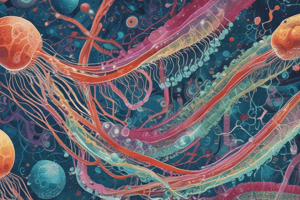Podcast
Questions and Answers
Flashcards are hidden until you start studying
Study Notes
Bacterial Appendages
- Bacterial cells can have various appendages for movement and attachment, including flagella, fimbriae, and sex pili; however, they do not have cilia.
- Spirochetes use periplasmic flagella for their twisting and flexing movement.
- Fimbriae are short and abundant appendages that help bacteria adhere to surfaces.
- Sex pili are tubular appendages used for genetic material transfer during bacterial conjugation.
Bacterial Structures and Functions
- Every bacterial cell contains a chromosome, which is organized within a region called the nucleoid.
- The presence of flagella allows bacteria to exhibit chemotaxis, directing movement toward chemicals in their environment.
- Capsules are protective structures that shield bacteria from being engulfed by immune cells.
Cell Wall Characteristics
- The Gram stain classification is based on differences in bacterial cell wall composition; gram-positive bacteria have thick peptidoglycan layers, while gram-negative bacteria have an outer membrane containing lipopolysaccharides.
- Peptidoglycan is a unique macromolecule found exclusively in bacterial cell walls, crucial for structural integrity.
Endospores
- Bacterial endospores serve as a protective mechanism for genetic material during adverse conditions; they are resistant to heat, radiation, and chemicals.
- Calcium dipicolinic acid presence indicates the presence of endospores, which are metabolically inactive during dormancy.
Shape and Arrangement of Bacteria
- Bacteria are classified by their shapes: cocci (spherical), rods (bacilli), spirilla (spiral), and specific arrangements like sarcinae (cuboidal packets).
- Coccobacillus refers to short and plump rod-shaped bacteria.
Biofilms and Evolution
- Biofilms are complex communities of microbes that cooperate and adapt, playing roles in ecological recycling and medical device colonization; they are difficult to eliminate with antimicrobials.
- The similarity in nitrogen base sequences of rRNA is an essential criterion for determining evolutionary relatedness among bacteria.
Phyla of Bacteria
- Bacterial phyla include Gracilicutes (gram-negative), Firmicutes (gram-positive), and Actinobacteria, which feature unique characteristics like waxy cell walls.
- Cyanobacteria are notable for their photosynthetic capabilities and presence of thylakoids for light absorption.
Miscellaneous Knowledge
- Lysozyme, found in tears, defends against bacteria by hydrolyzing peptidoglycan in cell walls.
- The mordant in Gram staining is iodine, which stabilizes the dye within the cell wall.
- Plasmids are crucial vectors in genetic engineering techniques due to their role in gene transfer among bacteria.
- Certain microorganisms thrive in extreme environments; for instance, Archaea can survive in highly acidic and hot habitats.
Mismatches in Classification
- Identifying mismatches in characteristics can clarify misconceptions; for example, Coxiella burnetti is associated with Q fever, not cowpox.
- Similarly, while Actinobacteria have waxy acid-fast walls, they differ from typical gram-positive structures.
Properties of Living Cells
- Living cells exhibit key characteristics such as boundary formation and ability to replicate; however, the presence of a nucleus is not a property exclusive to all living things, particularly in prokaryotic cells.
Studying That Suits You
Use AI to generate personalized quizzes and flashcards to suit your learning preferences.




